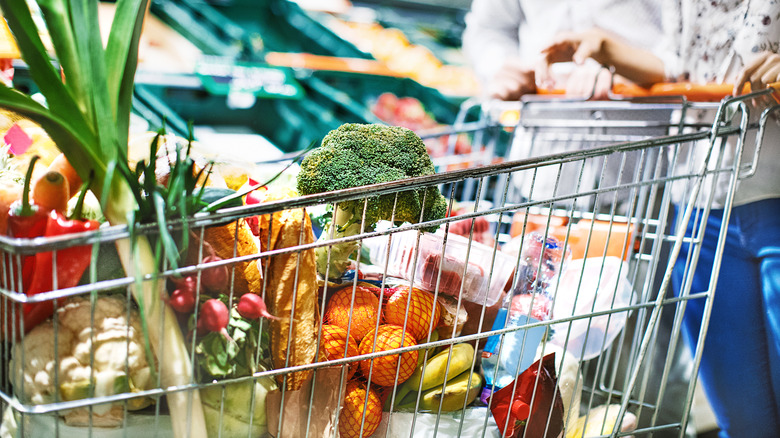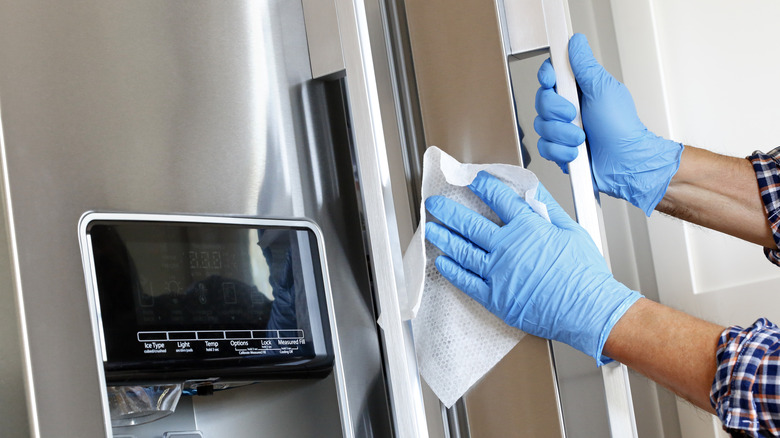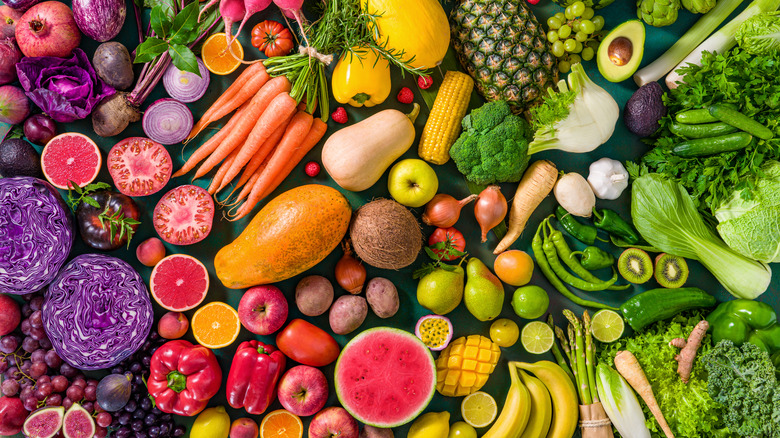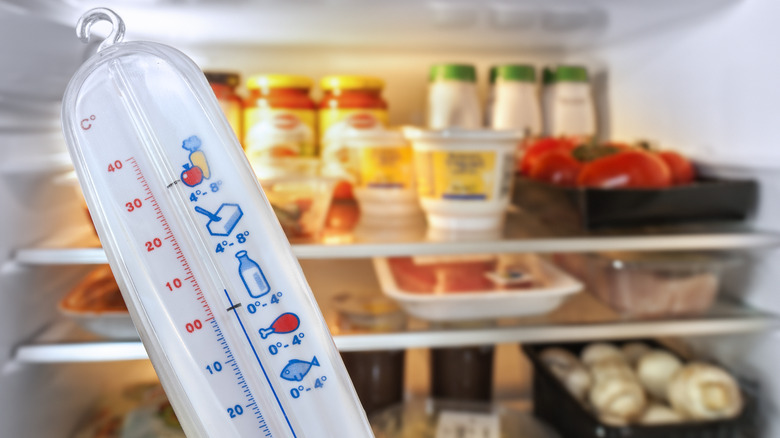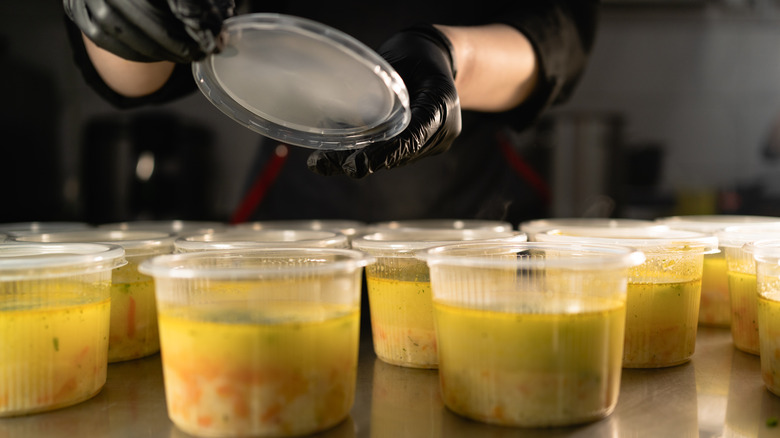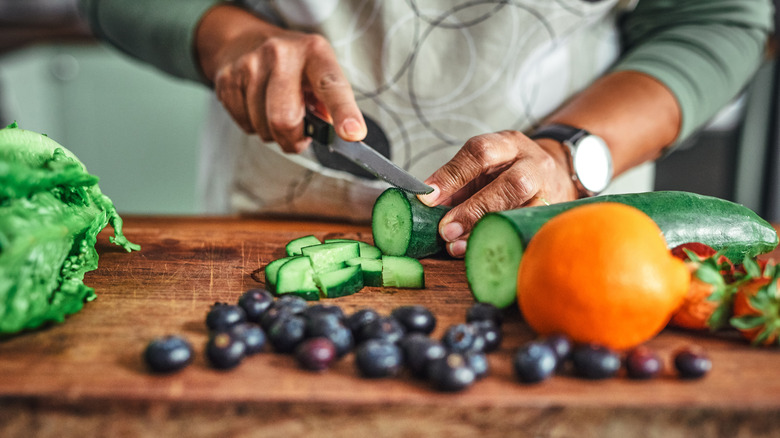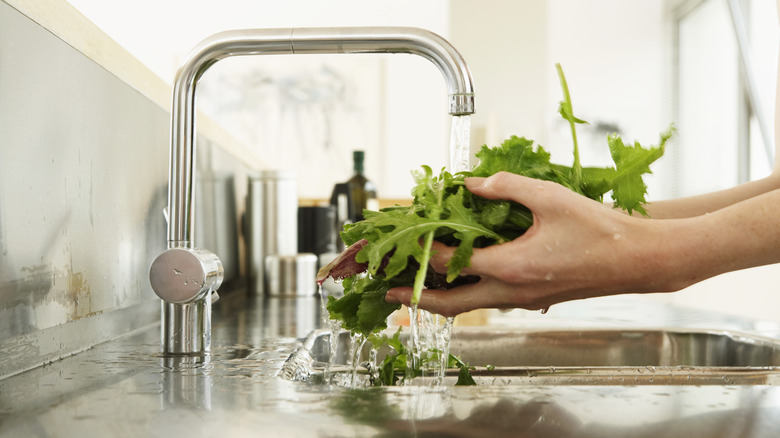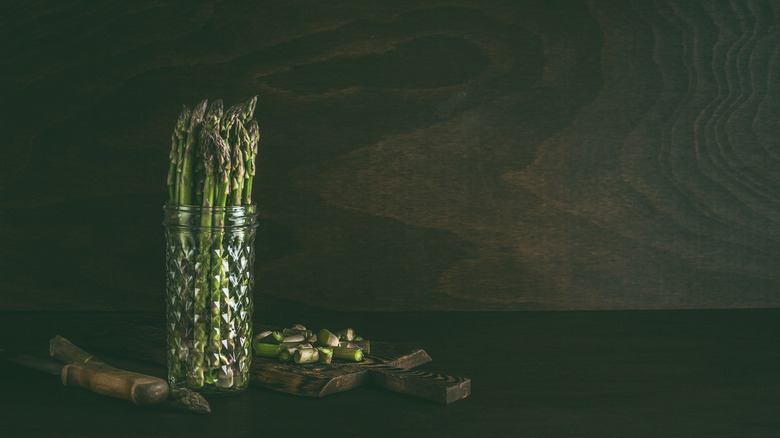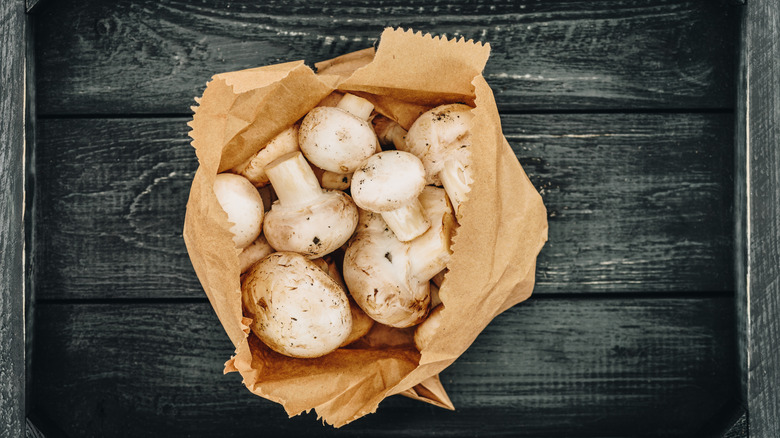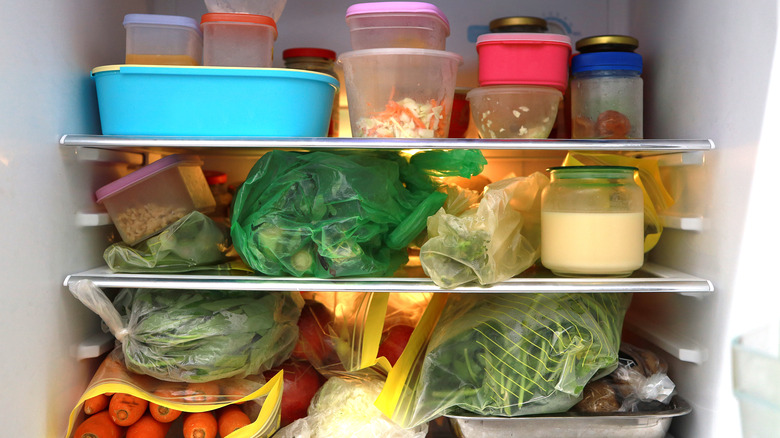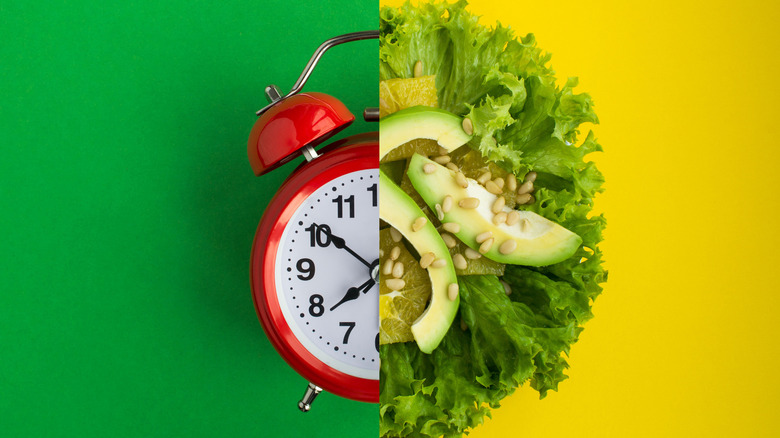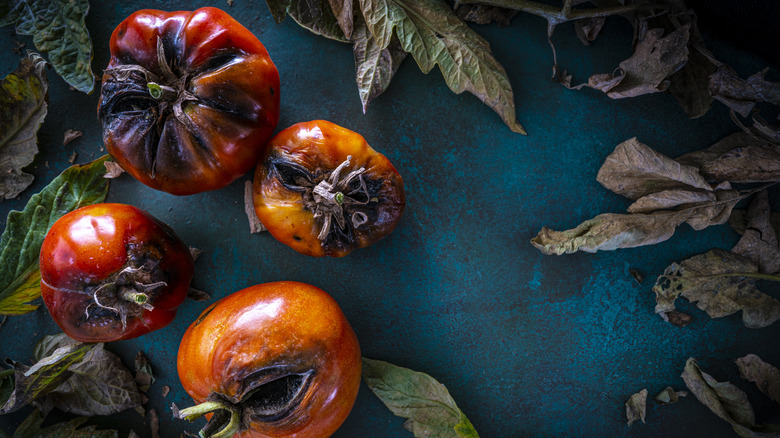How To Store Vegetables To Last Longer In The Fridge
After a long morning supermarket hopping and scouring the aisles of ShopRite, Aldi, and Costco, it's likely that all you want to do is throw your groceries into the refrigerator, scoop into the chocolate ice cream you just bought, and call it a day. After all, with their convenient packaging, putting your vegetables away might seem like a mindless, no-brainer task. But instantly jamming your items into the cold storage box is one of the biggest produce storage mistakes to avoid. Instead, be mindful of some important tips and tricks that help you store veggies so they last longer in the fridge.
Simply changing the way you group groceries and place them within the refrigerator, as well as how you maintain the cleanliness and temperature of the appliance itself, can make all the difference in whether your food lasts a few days or several weeks. Not only will adapting to these habits increase your groceries' shelf life and reduce food waste, but it can save your ingredients from losing essential nutrients and flavor.
Clean the fridge
How can you maximize your vegetables' freshness if the place you're keeping it isn't even up to code? Whether it's a milk spill you never wiped up or the crumbs you never brushed off, unsanitary fridges can lead to the growth of mold and other harmful bacteria, causing food spoilage and even food poisoning. Regularly cleaning your fridge is a fundamental part of food safety. Plus, an organized fridge is key to a stress-free dinner party; who wants to see that the dishes you've been serving come from a place riddled with germs?
The CDC recommends using a simple cleaning routine that consists of just a few steps. Begin by taking out and setting all the contents of your fridge on a nearby table, discarding any old, expired food in the process. Take out any removable parts of the fridge, such as shelves and drawers, and wash them using hot water and soup. Be sure the compartments are at room temperature before doing so, as dousing cold glass under hot water can lead to breakage and cracking. Use soap and water to scrub the fridge interior, too, including any other parts that couldn't be removed earlier. Rinse off the soap with water, and dry thoroughly with a clean towel. Once your removable parts have also been wiped clean and dried, you may return them. Those looking for an extra deep clean can prepare a ratio of 1 tablespoon of bleach per 1 gallon of water, in addition to using soap.
Separate gaseous fruits and veggies
With their high amounts of fiber, antioxidants, vitamins, and minerals, fruits and vegetables share a positive reputation for being crucial to a nutritious, well-balanced diet. That's pretty much where their similarities end, though. One of the largest differences between the two food groups is a chemical compound called ethylene. Ethylene is a colorless gas that breaks down chlorophyll and affects the way plants develop and make energy. Some vegetables, like corn and berries, are the exception and are not as notably affected by this. But most produce either emit high amounts of ethylene as they ripen, and some barely give off any at all.
Most fruits and some veggies, with apples, melons, mangoes, and plantains as examples, are strong ethylene producers. They should be stored alone or separately from foods that produce less of the gas. Ethylene-sensitive veggies include cabbage, cauliflower, carrots, and eggplants. As a basic guideline to follow, separate fruits and veggies altogether. Placing them near each other may cause your more delicate produce to ripen earlier than it's meant to, shortening their shelf life. That's where the hack of making your avocado ripen faster by placing it in a bag with fruit comes from.
Manage the fridge's temperature and humidity
For the reasons stated above, most fridge models will come with drawers that help you easily separate your varying produce items. Particularly important is the crisper drawer, which maintains a different humidity than all other parts of your fridge. It can be manipulated to have either higher or lower humidity, depending on what you plan to store there. Vegetables that require higher moisture levels to stay fresh, such as leafy greens, cucumbers, and okra, belong in a higher humidity setting. This will protect them from being exposed to the high amount of ethylene gas that vegetables such as avocados, peppers, and tomatoes give off. Foods that expel more ethylene gas can stay in lower-humidity environments as they aren't prone to losing moisture quickly.
The fridge's temperature is just as important, if not more, than your fridge's humidity. Depending on how old or new your refrigerator's model is, the appliance will have either a turnable dial, a digital display, or a sliding gauge that allows you to control its temperature. The interior should ideally be between 35 to 38℉, always remaining under 40℉. Any lower than 35℉, and you run the risk of freezing your food. Inversely, any higher than 40℉ will lead to quicker food spoilage.
Properly store hot food
It's not uncommon for people to throw a large batch of freshly cooked food into the fridge or freezer, or return a recently heated meal to its spot in the fridge before it has the chance to cool down. Though it might seem like a harmless habit, doing so might actually put you into what's known as the "danger zone."
This term refers to when the fridge's temperature hits between 40℉ and 140℉. Surpassing the upper limit of the ideal fridge temperature range creates an environment where harmful bacteria can thrive. Even if your appliance's thermostat is set to under 40℉, putting large amounts of hot food in the fridge can cause the overall temperature to increase, prompting the rapid growth of pathogens, including but not limited to E. coli and Salmonella. According to the USDA, all it takes is 20 minutes in this heated environment and bacteria can almost double in number, potentially spoiling your vegetables and making them unsafe to eat.
To combat this threat, look at this simple roasted butternut squash soup recipe as an example. The recipe yields a generous six servings. Don't pour it all into one large Tupperware to be kept in the fridge once you're done cooking. Instead, separate large portions of hot food into small, shallow containers that allow the dish to cool more quickly. Ensure it's properly covered to keep it from spreading heat and protect your veggies from becoming breeding grounds for bacteria.
Avoid pre-cutting produce
Cutting and peeling ingredients in advance of when you're going to cook them might seem like a timesaver, but it actually hastens the time by which you'll have to use them. In contrast to their whole counterparts, whose interiors are protected by skin and peels, pre-cut produce is prone to oxygen, heat, and light exposure. Unfortunately, what appears convenient and efficient is the cause for reduced nutritional value in these pre-sliced and pre-chopped veggies.
The science behind this lies right in the name of one of the biggest nutrients lost in pre-cut veggies: antioxidants. Antioxidants, such as vitamins C, A, and E, are responsible for preventing cell damage. As expressed by their name, though, these natural molecules react poorly and are lessened in the presence of oxygen in the air, which is hard to avoid when the inside of your veggies has already been busted open. Pre-cut produce also spoils more quickly due to its raised respiration rate. This refers to the breaking down of sugars and the release of carbon dioxide in food, affecting the ripening process and making it go bad faster.
Avoid pre-washing vegetables
It might seem counterintuitive, but avoid washing your vegetables ahead of the time you're consuming them. To maximize your veggies' freshness, save the rinsing for right when you're about to eat. This is because pre-washing produce creates excess moisture and condensation that your food will have to sit in until it gets used. Condensation within the fridge is normal due to the cooling and humidity processes, but too much of it may bring about mold and an unpleasant odor. That's why a commonly used hack is lining your shelves and drawers with paper towels; they work to absorb any extra moisture that may lead to your food rotting faster.
If for any reason you must wash your veggies immediately upon taking them home from the supermarket, such as if you see any soil or debris, thoroughly pat them dry with clean paper towels before storing them. Otherwise, giving your ingredients a proper rinsing is a task that can be saved for later on. Washing them prematurely will only give bacteria the damp environment they need to thrive, allowing them plenty of time to fester and grow before you actually use your veggies.
Keep leafy greens in water
Though it's generally advised to keep your veggies as dry as possible until right before preparation or consumption, there are a few exceptions to the rule. Water has the opposite effect on some leafy vegetables, prolonging their life and at times even reviving the ones that have begun to wilt. A few of these outliers include celery, green onions, chives, cilantro, and asparagus. Treat these water-loving ingredients as you would a bouquet of flowers and watch how they last longer.
All you have to do is trim about an inch off the ends of your stalk. Then stand it upright in a mason jar, glass, or vase that has 2 inches of cold water at the bottom. This water should be changed regularly, especially if you notice its color becoming cloudy. Cover the top of your bunch by loosely placing a plastic bag around it. A space-saving alternative to this method is to wrap your vegetables in a damp paper towel and seal them in a loose plastic baggie before putting them in the refrigerator.
Choose appropriate packaging
The fridge will do its part to keep everything inside of it chilly, but to give your produce the best chance of maintaining its optimal texture and taste, you have to be a bit more meticulous with how you store your food. You've already learned leafy greens should be kept in a glass of water. Similarly, certain vegetables need to be repackaged or tended to before being placed in the fridge while others are fine to be left as they are.
For instance, mushrooms should not be stored in plastic bags. With their high level of moisture, they don't react well to the trapped humidity within that type of storage. They do best being transferred to breathable paper bags that allow for both air circulation and moisture absorption. Likewise, herbs that are typically sold in bunches (rosemary, thyme, and basil to name a few), need room to breathe, too. Rubber bands or twist ties holding the bunch together should be removed, and the stems should be separated.
Another storage trick is to line the containers holding your pre-cut produce with a damp paper towel to keep the contents crisp. Cabbage and Brussels sprouts can be kept in a plastic bag or the plastic wrapping they came in. And for corn, leave the husks on as an extra layer of protection to help retain moisture. Each vegetable has its own storage nuances, and it's worth delving into the specifics to make sure you're keeping them around long enough to enjoy.
Don't overfill the fridge
Having the means to fully stock the fridge is a blessing; seeing it piled high with an assortment of snacks and ingredients is every foodie's dream. But if you fill it to the point of food spoilage, it can turn into a nightmare. It's not uncommon for food to rot faster in an overfilled fridge. How are you going to remember your loaded beef taco casserole from two nights ago if it has been buried under a pile of cherry tomatoes and cheese slices? Chances are, you won't get around to eating the dishes and ingredients that have been pushed to the back of the refrigerator. And if you're oblivious to the fact that food has gone bad inside, it increases the risk of cross-contamination among your fridge contents.
Not only will you lose sight of what needs to be eaten or thrown out if your fridge is packed too densely, but it's possible that your groceries will block the vents and disrupt the appliance's airflow. This will leave some veggies getting too cold and partially freezing while others don't get cold enough, hastening their spoil time. So be mindful of how much produce you purchase at once, as well as what you choose to refrigerate. Not everything belongs in the fridge; save some space and money by placing the appropriate items elsewhere.
Track their lifespan
Even with implementing every tip and trick to stretch your vegetables' lifespan, you can't ignore when your ingredients are simply reaching the end of their shelf life. Some foods will fare better past their typical expiration date than others, but it's always a good rule of thumb to know the estimated timeline of when to use your stock. Avocados, broccoli, and cauliflower, for instance, last between three to five days in the fridge. On the other hand, root vegetables like carrots, turnips, and radishes can last from two to three weeks. Lettuce can be stored for about one to two weeks.
Taking note of how long each individual veggie is expected to last against how long you've already had them will help you prioritize which produce should be eaten first. Keep your refrigerated food on rotation by placing the longest-lasting items toward the back of the appliance and the items that spoil quickly toward the front. To illustrate the point, pretend you purchased both mushrooms and parsnips yesterday. If you had to choose between the two, mushrooms, which last four to 10 days, should be incorporated into a dish sooner than your parsnips, which can stay strong for up to three weeks. Also, be sure to use your oldest produce first. That way, you have a chance to utilize all your produce before it goes bad.
Know when to toss produce
You shouldn't rely on just the smell test when it comes to food safety. Other telltale signs of rotten produce will eventually come, despite your best efforts to make your vegetables last longer in the fridge. A slimy or squishy texture, a change in color and taste, and mold are all indicators of your food going bad. Vegetables showing any of these symptoms should either be thrown out or composted if possible.
If not, leaving expired produce in your refrigerator can lead you to accidentally ingest it and contract food poisoning. Similar to what happens if you overfill your appliance, it can also increase the risk of cross-contamination between your ingredients. Your recently spoiled tomatoes that have grown mold might touch your perfectly fine squash, opening the possibility of bacteria to transfer between the two items and making both less safe to consume. So even if it's a bitter parting, it's better to know when to toss your produce than to let it overstay its welcome in your refrigerator.
